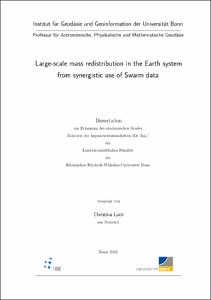Lück, Christina: Large-scale mass redistribution in the Earth system from synergistic use of Swarm data. - Bonn, 2022. - Dissertation, Rheinische Friedrich-Wilhelms-Universität Bonn.
Online-Ausgabe in bonndoc: https://nbn-resolving.org/urn:nbn:de:hbz:5-65204
Online-Ausgabe in bonndoc: https://nbn-resolving.org/urn:nbn:de:hbz:5-65204
@phdthesis{handle:20.500.11811/9572,
urn: https://nbn-resolving.org/urn:nbn:de:hbz:5-65204,
author = {{Christina Lück}},
title = {Large-scale mass redistribution in the Earth system from synergistic use of Swarm data},
school = {Rheinische Friedrich-Wilhelms-Universität Bonn},
year = 2022,
month = jan,
note = {Long and consistent time series of large-scale mass redistribution in the Earth system are important in many scientific research areas. The dedicated Gravity Recovery And Climate Experiment (GRACE) and Gravity Recovery And Climate Experiment Follow-On (GRACE-FO) satellite missions provide time-variable gravity fields with an unprecedented accuracy and thus contribute significantly to a better understanding of mass fluctuations within the Earth. However, it is important to find alternatives, because the GRACE(-FO) record is interrupted by an 11-months data gap and several (bi-)monthly gaps. Alternative approaches could help to fill the gaps and to extend the time series into the past and future.
In this thesis, time-variable gravity fields and large-scale mass redistribution are derived from the magnetic field mission Swarm, which is not specifically designed to measure the Earth’s gravity field. The integral equation approach with short arcs is used to derive Spherical Harmonic (SH) coefficients from kinematic orbits of the three satellites. As accelerometer measurements are corrupted by a variety of errors, non-gravitational accelerations are modeled, which improves the gravity field solutions. Different parameterizations are tested and the quality of the results is validated by comparing them to the more accurate GRACE(-FO) solutions during the overlap period. The analysis reveals that the Swarm solution derived in this thesis provides better results than the official European Space Agency (ESA) EGF_SHA_2_ product from July 2015 to December 2019 and similar results in the remaining months. Swarm is able to resolve mass change trends and seasonal signals from basin averages when either a large basin (e.g., ocean) or a region with a high signal content (e.g., Danube river basin) is investigated. Swarm can be used to fill the gap between GRACE and GRACE-FO and should be preferred to common GRACE(-FO) data interpolation methods. First results reveal that time-variable gravity fields from Swarm can be integrated in a sea level inversion framework with the aim to partition altimetric sea level change into its individual components.},
url = {https://hdl.handle.net/20.500.11811/9572}
}
urn: https://nbn-resolving.org/urn:nbn:de:hbz:5-65204,
author = {{Christina Lück}},
title = {Large-scale mass redistribution in the Earth system from synergistic use of Swarm data},
school = {Rheinische Friedrich-Wilhelms-Universität Bonn},
year = 2022,
month = jan,
note = {Long and consistent time series of large-scale mass redistribution in the Earth system are important in many scientific research areas. The dedicated Gravity Recovery And Climate Experiment (GRACE) and Gravity Recovery And Climate Experiment Follow-On (GRACE-FO) satellite missions provide time-variable gravity fields with an unprecedented accuracy and thus contribute significantly to a better understanding of mass fluctuations within the Earth. However, it is important to find alternatives, because the GRACE(-FO) record is interrupted by an 11-months data gap and several (bi-)monthly gaps. Alternative approaches could help to fill the gaps and to extend the time series into the past and future.
In this thesis, time-variable gravity fields and large-scale mass redistribution are derived from the magnetic field mission Swarm, which is not specifically designed to measure the Earth’s gravity field. The integral equation approach with short arcs is used to derive Spherical Harmonic (SH) coefficients from kinematic orbits of the three satellites. As accelerometer measurements are corrupted by a variety of errors, non-gravitational accelerations are modeled, which improves the gravity field solutions. Different parameterizations are tested and the quality of the results is validated by comparing them to the more accurate GRACE(-FO) solutions during the overlap period. The analysis reveals that the Swarm solution derived in this thesis provides better results than the official European Space Agency (ESA) EGF_SHA_2_ product from July 2015 to December 2019 and similar results in the remaining months. Swarm is able to resolve mass change trends and seasonal signals from basin averages when either a large basin (e.g., ocean) or a region with a high signal content (e.g., Danube river basin) is investigated. Swarm can be used to fill the gap between GRACE and GRACE-FO and should be preferred to common GRACE(-FO) data interpolation methods. First results reveal that time-variable gravity fields from Swarm can be integrated in a sea level inversion framework with the aim to partition altimetric sea level change into its individual components.},
url = {https://hdl.handle.net/20.500.11811/9572}
}






